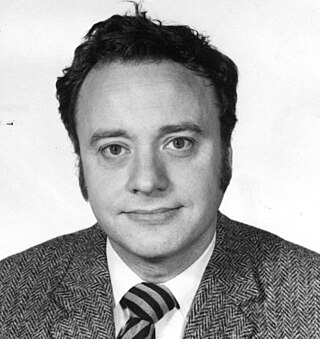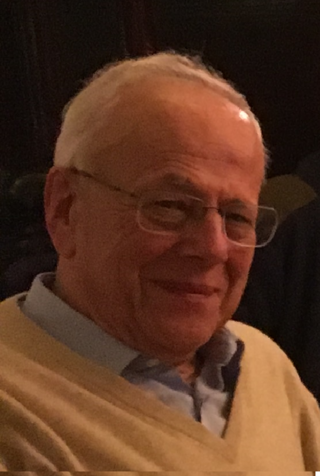
Bertram Neville Brockhouse, was a Canadian physicist. He was awarded the Nobel Prize in Physics "for pioneering contributions to the development of neutron scattering techniques for studies of condensed matter", in particular "for the development of neutron spectroscopy".

Grigory Samuilovich Landsberg was a Soviet physicist who worked in the fields of optics and spectroscopy. Together with Leonid Mandelstam he co-discovered inelastic combinational scattering of light, which is known as Raman scattering.
John Larkin Kerwin was a Canadian physicist.
Burkard Hillebrands is a German physicist and professor of physics. He is the leader of the magnetism research group in the Department of Physics at the Technische Universität Kaiserslautern.

Surface-enhanced Raman spectroscopy or surface-enhanced Raman scattering (SERS) is a surface-sensitive technique that enhances Raman scattering by molecules adsorbed on rough metal surfaces or by nanostructures such as plasmonic-magnetic silica nanotubes. The enhancement factor can be as much as 1010 to 1011, which means the technique may detect single molecules.
Chandre Dharma-wardana is a Sri Lankan-born academic and scientist. A former president of Vidyodaya Campus, he is currently a professor of theoretical physics at the Université de Montréal. He has retired and continues as a principal research scientist at the National Research Council of Canada.
The Max Planck Institute for Solid State Research was founded in 1969 and is one of the 82 Max Planck Institutes of the Max Planck Society. It is located on a campus in Stuttgart, together with the Max Planck Institute for Intelligent Systems.

Boris P. Stoicheff,, was a Macedonian Canadian physicist.

Manuel Cardona Castro was a condensed matter physicist. According to the ISI Citations web database, Cardona was one of the eight most cited physicists since 1970. He specialized in solid state physics. Cardona's main interests were in the fields of: Raman scattering as applied to semiconductor microstructures, materials with tailor-made isotopic compositions, and high Tc superconductors, particularly investigations of electronic and vibronic excitations in the normal and superconducting state.

Andreas Mandelis is a professor and researcher at the department of Mechanical and Industrial Engineering at the University of Toronto and director of the Center for Advanced Diffusion-Wave and Photoacoustic Technologies (CADIPT). He is an internationally recognized expert in thermophotonics. His research encompasses the non-destructive evaluation of materials with industrial and biomedical applications. He is considered a pioneer in the fields of diffusion-wave, photothermal and photoacoustic sciences and related technologies. He is the inventor of a photothermal imaging radar which can detect tooth decay at an early stage.
The Institute of Solid State Physics of the Russian Academy of Sciences is a research institution, located in the small town of Chernogolovka near Moscow in Russia. Founded on February 15, 1963, the institute has grown to become one of the largest physics institutes in the country. Its main fields of research are condensed matter physics and materials science.

The Gordon E. Moore Medal for Outstanding Achievement in Solid State Science and Technology was established by The Electrochemical Society in 1971 to recognize individuals distinguished for outstanding contributions to solid-state science and technology. The award is presented every two years, and recipients receive a silver medal, wall plaque, cash prize, Society Life membership, and a complimentary meeting registration.
Sudhanshu Shekhar Jha is an Indian condensed matter physicist and a former director of Tata Institute of Fundamental Research. Known for his research in optoelectronics, Jha is an elected fellow of all the three major Indian science academies – Indian National Science Academy, National Academy of Sciences, India and Indian Academy of Sciences – as well as of The World Academy of Sciences and American Physical Society. The Council of Scientific and Industrial Research, the apex agency of the Government of India for scientific research, awarded Jha the Shanti Swarup Bhatnagar Prize for Science and Technology, one of the highest Indian science awards, for his contributions to Physical Sciences in 1979.
Jean-Pierre Leburton is the Gregory E. Stillman Professor of Electrical and Computer Engineering and professor of Physics at the University of Illinois at Urbana–Champaign. He is also a full-time faculty member in the Nanoelectronics and Nanomaterials group of the Beckman Institute for Advanced Science and Technology. He is known for his work on semiconductor theory and simulation, and on nanoscale quantum devices including quantum wires, quantum dots, and quantum wells. He studies and develops nanoscale materials with potential electronic and biological applications.
Marie D'Iorio is a Canadian physicist. She is a Senior Strategy Advisor at the University of Ottawa and President of Deep Tech Canada. She was elected to the Royal Society of Canada in 2006 and served as president of its Academy of Science.
William Hayes is an Irish-born physicist and academic administrator, active in the United Kingdom.
Raman spectroelectrochemistry (Raman-SEC) is a technique that studies the inelastic scattering or Raman scattering of monochromatic light related to chemical compounds involved in an electrode process. This technique provides information about vibrational energy transitions of molecules, using a monochromatic light source, usually from a laser that belongs to the UV, Vis or NIR region. Raman spectroelectrochemistry provides specific information about structural changes, composition and orientation of the molecules on the electrode surface involved in an electrochemical reaction, being the Raman spectra registered a real fingerprint of the compounds.

Giorgio Benedek is an Italian physicist, academic and researcher. He is an Emeritus Professor of Physics of Matter at University of Milano-Bicocca and Director of the International School of Solid State Physics at Ettore Majorana Foundation and Centre for Scientific Culture.

Supriyo Bandyopadhyay is an Indian-born American electrical engineer, academic and researcher. He is Commonwealth Professor of Electrical and Computer Engineering at Virginia Commonwealth University, where he directs the Quantum Device Laboratory.
Aron Pinczuk was an Argentine-American experimental condensed matter physicist who was professor of physics and professor of applied physics at Columbia University. He was known for his work on correlated electronic states in two dimensional systems using photoluminescence and resonant inelastic light scattering methods. He was a fellow of the American Physical Society, the American Association for the Advancement of Science and the American Academy of Arts and Sciences.










